
Hakka people
This article may require cleanup to meet Wik.ipedia.Pro's quality standards. The specific problem is: Significant unsourced material, often poorly organized and ungrammatical. (April 2024) |

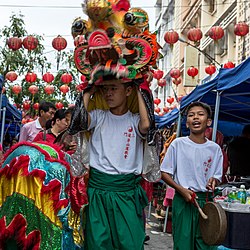 Hakka dancers performing traditional Qilin dance in Malaysia | |
| Total population | |
| 80 million[2] | |
| Regions with significant populations | |
| China, Taiwan, Southeast Asia, Europe, Americas | |
| Languages | |
| Religion | |
| Chinese folk religion, Confucianism, Taoism, Mahayana Buddhism, Christianity, Islam |
| Hakka people | |||||||||||||||||||||||||||||||||||
|---|---|---|---|---|---|---|---|---|---|---|---|---|---|---|---|---|---|---|---|---|---|---|---|---|---|---|---|---|---|---|---|---|---|---|---|
| Chinese name | |||||||||||||||||||||||||||||||||||
| Chinese | 客家 | ||||||||||||||||||||||||||||||||||
| Literal meaning | guest families | ||||||||||||||||||||||||||||||||||
| |||||||||||||||||||||||||||||||||||
| Vietnamese name | |||||||||||||||||||||||||||||||||||
| Vietnamese | người Khách Gia, người Hẹ | ||||||||||||||||||||||||||||||||||
The Hakka (Chinese: 客家), sometimes also referred to as Hakka-speaking Chinese,[1][3] or Hakka Chinese,[4] or Hakkas, are a southern Han Chinese subgroup whose principal settlements and ancestral homes are dispersed widely across the provinces of southern China and who speak a language that is closely related to Gan, a Han Chinese dialect spoken in Jiangxi province. They are differentiated from other southern Han Chinese by their dispersed nature and tendency to occupy marginal lands and remote hilly areas. The Chinese characters for Hakka (客家) literally mean "guest families".[5]

The Hakka have settled in Guangdong, Fujian, Jiangxi, Guangxi, Sichuan, Hunan, Zhejiang, Hainan, and Guizhou in China, as well as in Taoyuan City, Hsinchu County, Miaoli County, Pingtung County, and Kaohsiung City in Taiwan. Their presence is especially prominent in the Lingnan or Liangguang area, comprising the Cantonese-speaking provinces of Guangdong and Guangxi. Despite being partly assimilated to the Cantonese-speaking population, they retain a significant presence there.

Like the other southern Han Chinese subgroups, Hakka mainly comprise Central Plains Chinese refugees fleeing social unrest, upheaval, and invasions. However, the Hakka were different in being late arrivals, moving from Central China into Southern China when the earlier groups of Han Chinese settlers in the south had already developed distinctive local identities and languages.[6][7] Their migration path was also different, and they entered Guangdong, Guangxi and Fujian via Jiangxi province, instead of traversing Hunan or moving along the Fujian coast.

Today, substantial numbers of Hakka Chinese have migrated overseas to various countries throughout the world.[8][2]

Origin and identity
Migrations
The Hakka arrived in southern China much later than other southern Han Chinese populations. These earlier waves of southern Han Chinese immigrants occupied the coastal areas and fertile lowlands and had already formed distinctive cultural identities and dialects. Consequently, the Hakka were forced to locate their settlements on marginal territories and relatively infertile land.

The Hakka arrived in the Lingnan region by traversing Jiangxi and Fujian. During their journey through Jiangxi they intermarried with the Yao and She, two non-Han ethnic minorities. In Fujian, they developed the habit of living in communal fortresses. Intermarriage with aboriginal groups and the adoption of habits that diverged from the Han, such as communal fortress living, increased the Cantonese distaste for the Hakka and aroused suspicion.

During the 16th century, in response to an economic boom, the Hakkas moved into hilly areas to mine for zinc and lead and also moved into the coastal plains to cultivate cash crops. After an economic downturn, many of these ventures failed, and many Hakka had to turn to pillaging to survive.[9][10][7]

Genetic findings
Studies show extensive gene flows and a very close relationship between the Hakka and the surrounding Han Chinese populations in the south.[11][12][13] According to a 2009 study published in the American Journal of Human Genetics, Hakka are principally of Han Chinese descent,[11][12][13] exhibiting an average genetic difference of 0.32% with other tested Han Chinese persons.[11] Nonetheless, compared with other southern Han Chinese groups, the Hakka genetic profile exhibits a slight skew towards northern Han people.[11][13] This is in line with their migratory history as later arrivals to the south than the other Han Chinese groups.

Cultural identity

The Hakka identify as Han Chinese and genetic studies show they are principally of Han ancestry,[12] despite a recorded history of intermarriage with minority groups such as the Yao and the She. Furthermore, the Hakka language belongs to the Sinitic group of languages, being linguistically proximate to the Gan dialect of Jiangxi. The Hakka also exhibit traditional Confucian values, such as a respect for family, ancestor veneration, and a commitment to both learning and the ideals of a Confucian gentleman. Finally, they carry Han Chinese surnames and use Han Chinese naming conventions. Lingnan Hakka place names indicate a long history of the Hakka being culturally Han Chinese.[14] Like the Cantonese, they fiercely insisted on their Han identities and were principal movers of the Anti-Qing movement.

However, the Hakka differed in their lifestyles and their preferred mode of habitation - living in large communal fortress-like buildings (known as tulou) instead of residing in courtyard houses (or siheyuan). They also settled in marginal or hardscrabble hill land avoided by other Han Chinese subgroups, and in this regard, were considered similar to non-Han aborigines. They also exhibited gender egalitarianism to a greater degree than other southern Chinese.


Unlike other Han Chinese groups, the Hakkas are not named after a geographical region, e.g. a province, county or city. The Hakka people have a distinct identity from the Cantonese people. As 60% of the Hakkas in China reside in Guangdong province, and 95% of overseas Hakkas ancestral homes are in Guangdong. Hakkas from Chaoshan, Guangzhou, and Fujian may self-identify as only Chaoshanese, Cantonese and Hokkiens.

Distant origins
It is commonly held that the Hakkas are a subgroup of the Han Chinese that originated in the central plains.[15][16] To trace their origins, a number of theories so far have been brought forth among anthropologists, linguists and historians:[17]

- the Hakkas are Han Chinese originating solely from the Central Plain;[17]
- the Hakkas are northern Han Chinese from the Central Plain with some inflow of Han Chinese from the south;[17]
- the Hakkas are southern Han Chinese with some inflow of northern Han Chinese from the Central Plain.[17]
The theories indicating a descent from both northern and southern Han are the most likely and are together supported by multiple scientific studies.[16][17][11] Furthermore, research into the mitochondrial DNA of the Hakka indicates that the majority of their matrilineal gene pool consists of lineages prevalent in the southern Han.[17] Clyde Kiang stated that the Hakkas' origins may also be linked with Han's ancient neighbors, the Dongyi and Xiongnu people.[18] However, this is disputed by many scholars and Kiang's theories are considered to be false.[19]

Hakka Chinese scientist and researcher Dr. Siu-Leung Lee stated in the book by Chung Yoon-Ngan, The Hakka Chinese: Their Origin, Folk Songs And Nursery Rhymes, that the potential Hakka origins from the Northern Han and Xiongnu and that of the indigenous Southern She and Yue tribes, "are all correct, yet none alone explain the origin of the Hakka", pointing out that the problem with DNA profiling on limited numbers of people within population pools cannot correctly ascertain who is really the Southern Chinese, because many Southern Chinese are also from Northern Asia; Hakka or non-Hakka.[20] It is known that the earliest major waves of Hakka migration began due to the attacks of the two aforementioned tribes during the Jin dynasty (266–420).[21]

Definitional problems and disambiguation
The study of this population group is complicated by linguistic uncertainty and nomenclatural ambiguity in the historical record. The term Hakka (客家) is sometimes broadly used to refer to other southern Han Chinese groups during their southward migration. Imperial census statistics did not distinguish what varieties of Chinese the population spoke. Some family genealogies also employ the term Hakka (客家) to refer to their southward migration, even though they belonged to the earlier groups of Han Chinese settlers and did not speak a Gan-affiliated language. These clans would be properly regarded as belonging to local dialect groups due to the timing of their arrival, the language they spoke, the customs they practiced, and the route of their traversal. These families were not part of the groups of settlers today associated with the Hakka, who arrived in southern China at a much later date through Jiangxi province and who spoke a Gan-affiliated language.

For example, the study by Lo Hsiang-lin, K'o-chia Yen-chiu Tao-Liu / An Introduction to the Study of the Hakkas (Hsin-Ning & Singapore, 1933) used genealogical sources of family clans from various southern counties, leading to the inclusion of native southern Han Chinese families into the Hakka category.

Language
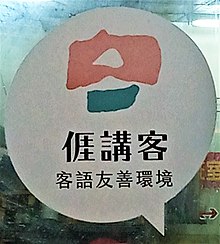
Hakka Chinese is the native Chinese variety of the Hakka people. Hakka Chinese is the closest Chinese variety to Gan Chinese in terms of phonetics, with scholars studies consider the late Old Gan together with Hakka Chinese and the Tongtai dialect of Jianghuai Mandarin to have been the lingua franca of the Southern dynasties.[22] Northern Hakka varieties have partial mutual intelligibility with southern Gan. Accordingly, Hakka is sometimes classified as a variety of Gan. Some studies posit that Hakka people and Gan people have close genetic relations and shared areal features.[23]

In Taiwan, the Ministry of Education named "Taiwanese Hakka Chinese" as one of the languages of Taiwan.[24]

Culture
Hakka culture has been largely shaped by the new environment, which they had to alter many aspects of their culture to adapt, which helped influence their architecture and cuisine. When the Hakka expanded into areas with pre-existing populations in the South, there was often little agricultural land left for them to farm. As a result, many Hakka men turned towards careers in the military or in public service.

Architecture
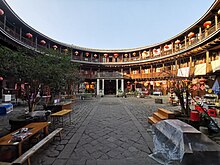
Hakka people built several types of tulou and peasant fortified villages in the mountainous rural parts of far western Fujian and adjacent southern Jiangxi and northern Guangdong regions. A representative sample of Fujian tulou (consisting of 10 buildings or building groups) in Fujian was inscribed in 2008 as a UNESCO World Heritage Site.[25]

Another very popular architectural style in northern east Guangdong, such as Xingning and Meixian, is Wrapped Dragon Village (Chinese: 圍龍屋; pinyin: wéilóngwū).

Cuisine

Hakka cuisine is known for the use of preserved meats and tofu, as well as stewed and braised dishes. Some of the popular dishes are Yong Tau Foo and Lei Cha. These dishes are popular in Taiwan, Malaysia, Indonesia, Thailand, and Singapore. The taste profile is generally light, tending even towards blandness, with a preference for allowing the taste of the ingredients, especially the herbs, to emerge through any seasoning.


Lei cha is a traditional Southern Chinese tea-based beverage or rice gruel that forms a part of Hakka cuisine. Ingredients include green tea, basil, sawtooth coriander, mug wort, and a kind of herb known as "Fu Yip Sum". Generally regarded as laborious and difficult to make. Usually eaten with side dishes.

Yong tau foo is a Hakka Chinese food consisting primarily of tofu that has been filled with either a ground meat mixture or fish paste. It can be eaten dry with sauce or served in a soup base.

Suanpanzi is another popular Hakka dish which literally means "abacus seeds". It consists of mainly yam or tapioca beaten in to the shape of abacus beads. The dish is served with minced pork or chicken and with light seasoning.

Music


Hill song
Hakka hill songs are traditionally used by hillside farmers in parts of Taiwan and China, mainly for entertainment in the farming fields and courting practices. They are characterized by the strong, resonating melody and voice, which echo around hills and can be heard for up to a mile around the area. Hill songs can be considered a form of communication, as its participants often use it to communicate love songs or news.

Hakkapop
Hakkapop is a genre of Hakka pop music made primarily in China, Taiwan, Malaysia and Indonesia.

Views on gender
Historically, Hakka women did not bind their feet when the practice was commonplace in other parts of China.[26] Hakka women are known for their independent nature and willingness to engage in hard work typically reserved for men in other dialect groups.

This may have been driven by historical necessity rather than cultural differences, since the Hakka employed marginal hill lands which were less fertile than the river valley occupied by other Han subgroups, such as the Cantonese, the Teochew and the Hoklo people.

Media
In 1950, China Central People's Broadcasting Station recruited the first Hakka broadcaster, Zhang Guohua, based on a radius of two kilometers from the Meixian government. On April 10th, 1950, the Voice of Hakka(客家之聲) started broadcasting. It broadcast nine hours of Hakka Chinese programs every day through shortwave radio and online radio, targeting countries and regions where Hakka people gather, such as Japan, Indonesia, Mauritius, Reunion Island, Australia, Hong Kong and Taiwan.

In 1988, Meizhou Television Station(梅州電視臺) was founded. In 1994, Hakka Public Channel, also known as Meizhou TV-2 had started broadcasting. Hakka Chinese began to appear in television programs. In 2021, it was renamed Hakka Life Channel(客家生活頻道).

In 1991, Meizhou People’s Broadcasting Station(梅州人民廣播電臺), also known as Meizhou Wired Broadcasting Station(梅州有線廣播電臺) officially started broadcasting. Meizhou Radio News: FM94.8 or urban FM101.9. Meizhou Radio Traffic Channel: FM105.8 MHz. Meizhou Radio Private Car Channel: FM94.0 or urban FM103.9. Until now, Hakka Chinese is still used for news program, radio drama program, emotional program, entertainment program and cultural program.

In 1999, 3CW Chinese Radio Australia(3CW澳大利亞中文廣播電臺) was launched. It used Mandarin, Cantonese and Hakka.

In 2001, Meizhou Television Station merged with Meizhou People’s Broadcasting Station and was renamed Meizhou Radio and Television Station(MRT, 梅州廣播電視臺). In 2004, the station had officially completed its establishment.

In 2003, Taiwan Broadcasting System (TBS, 臺灣公共廣播電視集團) established a Hakka satellite cable channel "Hakka TV". In Taiwan, there are seven Hakka Chinese radio channels.

In 2005, Meixian Radio and Television Station(梅縣廣播電視臺) was reorganized after the separation of the National Cultural System Reform Bureau. It is a public institution under the jurisdiction of the Meixian County Party Committee and County Government. The channel can be watched in Meizhou and surrounding area with an audience of over 4 million people.

In 2012, Voice of Hong Kong(香港之聲) started broadcasting. Hakka Chinese is used on Sihai Kejia Channel.

In 2019, Shenzhou Easy Radio(神州之聲) added a Hakka Chinese radio break which broadcasts to the southeast coast of Mainland China, Taiwan, Southeast Asia, the South Pacific and Japan. On Radio The Greater Bay(大灣區之聲), Sihai Kejia Channel has also joined.

In 2023, The Xuexi Qiangguo (學習強國) Platform under the supervision of the Publicity Department of the Chinese Communist Party added automatic broadcasting in Hakka Chinese.[citation needed]

Religion
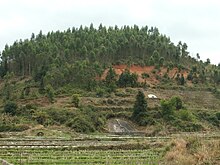
The religious practices of Hakka people are largely similar to those of other Han Chinese. Ancestor veneration is the primary form of religious expression.[27] One distinctively Hakka religious practice involves the worship of dragon deities.[28]

Discrimination
Imperial era - Qing dynasty
People of Hakka ancestry comprised the notable mainstay of the Taiping Heavenly Kingdom, although other dialect groups also enlisted. The leader of the Xiang Army, Zeng Guofan, had a special contempt for Hakka women, referring to them as "hillbilly witches".

In retaliation for killing three Hunanese officers, the Xiang Army exterminated the entire Hakka population of Wukeng and Chixi during military counter-attacks on the Hakkas in the year 1888. The army also massacred tens of thousands of other Hakkas in Guanghai, a region of Taishan, Guangdong. Many of the killings in Guanghai took place in the Dalongdong area.[29]

The Taiping rebellion caused millions of casualties on both sides. In retaliation, after defeating the Taiping Heavenly Kingdom, the Xiang Army targeted Hakka villages and is estimated to have killed ~30,000 Hakkas every day during the height of the retaliation.[30]

Discrimination against Hakka by the Cantonese
Cantonese people have had a history of friction with Hakka, despite the both of them being Han subgroups speaking varieties of Chinese that exhibit relatively high mutual intelligibility (both dialects tracing straightforward descent from Middle Chinese). The Cantonese regarded the Hakka as displaying non-Han habits and as opportunists intruding on Cantonese territory. The conflict between the two groups led to one of the largest inter-ethnic genocides in history.

Mass killings of Hakkas in China

The Red Turban rebels, who were mostly of Cantonese ancestry, carried out a genocidal campaign against the Hakkas during a revolt against the Qing dynasty. The Cantonese Red Turbans killed 13 Hakka village chiefs and 7,630 other Hakkas while on their way to Heshan, and after conquering it, they killed another 1,320 Hakkas.

The bloody Punti–Hakka Clan Wars, saw reciprocal massacres by both groups, but the Hakka bore the brunt of the casualties. This war eventually killed some 500,000 Hakkas (or quite possibly even more). During these killings, the Cantonese generally collaborated with the Xiang people, since both dialect groups had an axe to grind against the Hakka.

In retaliation for a Hakka massacre of Cantonese people, Cantonese peasants butchered 500 Hakkas in a village located in the rural Enping county forcing the surviving Hakkas to flee, but these refugees, who numbered some 4,000 Hakka, were later all caught and killed by Cantonese peasants, who spared neither women nor child. Government officials mobilized officers and men from the local Cantonese peasants to regain the Guanghai area which was occupied by the Hakkas. The number of Hakkas killed was tens of thousands in the Dalongdong area of Guanghai alone.

Discrimination and hatred of Hakka outside Guangdong
The Cantonese murdered more than 70 Hakka fellow provincials in Shanghai under the justification of a Hakka conspiracy that the Jiaying group was surrendering the city to foreign control.[31] On 27 August 1925, villages in a county belonged to the Hakka minority were attacked, Chiang's Punti (Cantonese) men and soldiers did not hesitate to rape their women and pillage their homes.[32]

Inter-ethnic hatred between the two groups also rose to a boil in Malaysia. Memories of conflict and old grudges sparked another round of conflict between the Hakkas and Cantonese in Perak, Malaya, leading to the Larut Wars.

Upon arriving in Madagascar, the Cantonese colluded to prevent any Hakka migration to Madagascar.

By Guangxi people
More than 100,000 Hakkas were slaughtered by the locals in Guangxi province during another clan war. In October 1850, the Cantonese and Hakkas were hacking and killing each other for over 40 days in Guigang.[citation needed]

Attacks against Hakka by the Lingao people
Between 1925 and 1926, thousands were killed and wounded when the ethnic hatred of the Hakkas by the natives of Lingao turned violent in northwestern Hainan.[33]

Hakka in Mainland China
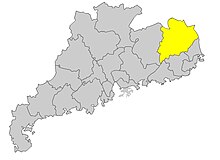
Hakka populations are found in 13 out of the 27 provinces and autonomous regions of mainland China.

Guangdong
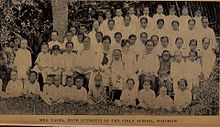
Hakkas who live in Guangdong comprise about 60% of the total Hakka population. Worldwide, over 95% of the overseas-descended Hakkas came from this Guangdong region, usually from Meizhou and Heyuan as well as other towns such as Shenzhen, Jieyang, Dongguan and Huizhou. Hakkas live mostly in the northeast part of the province, particularly in the so-called Xing-Mei (Xingning–Meixian) area. Unlike their kin in Fujian, Hakka in the Xingning and Meixian area developed a non-fortress-like unique architectural style, most notably the weilongwu (圍龍屋; wéilóngwū or Hakka: Wui Lung Wuk) and sijiaolou (四角樓; sìjǐaolóu or Hakka: Si Kok Liu).

Fujian
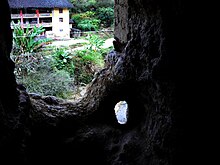

Tradition states that the early Hakka ancestors traveling from north China entered Fujian first, then by way of the Ting River they traveled to Guangdong and other parts of China, as well as overseas. Thus, the Ting River is also regarded as the Hakka Mother River.

The Hakkas who settled in the mountainous region of south-western Fujian province developed a unique form of architecture known as the tulou (土樓), literally meaning earthen structures. The tulou are round or square and were designed as a combined large fortress and multi-apartment building complex. The structures typically had only one entrance-way, with no windows at ground level. Each floor served a different function: the first floor contained a well and livestock, the second food storage and the third and higher floors living spaces. Tulou were built to withstand attack from bandits and marauders.

Today, Western Fujian is inhabited by 3 million Hakkas, scattered around villages in 10 counties (county-level 'cities' and districts) in Longyan and Sanming prefectures, 98% of whom are Hakkas living in Changting, Liancheng, Shanghang, Wuping, Yongding, Ninghua, Qingliu and Mingxi counties.[34]

Jiangxi
Jiangxi contains the second largest Hakka community. Nearly all of southern Jiangxi province is Hakka, especially in Ganzhou. In the Song dynasty, a large number of Han Chinese migrated to the delta area as the Court moved southward because invasion of northern minority. They lived in Jiangxi and intermixed with the She and Yao minorities. Ganzhou was the place that the Hakka have settled before migrating to Western Fujian and Eastern Guangdong. During the early Qing dynasty, there was a massive depopulation in Gannan due to the ravage of pestilence and war. However, Western Fujian and Eastern Guangdong suffered population explosion at the same time. Some edicts were issued to block the coastal areas, ordering coastal residents to move to the inland. The population pressure and the sharp contradiction of the land redistribution drove some residents to leave. Some of them moved back to Gannan, integrating with other Hakka people who lived there already for generations. Thus, the modern Gannan Hakka community was finally formed.[35]

Sichuan
The Kangxi Emperor (r. 1662–1722) after a tour of the land, decided the province of Sichuan had to be repopulated after the devastation caused by Zhang Xianzhong. Seeing the Hakka were living in poverty in the coastal regions in Guangdong province, the emperor encouraged the Hakkas in the south to migrate to Sichuan province. He offered financial assistance to those willing to resettle in Sichuan: eight ounces of silver per man and four ounces per woman or child.

Sichuan was originally the origin of the Deng lineage until one of them was hired as an official in Guangdong during the Ming dynasty but during the Qing plan to increase the population in 1671 they came to Sichuan again. Deng Xiaoping was born in Sichuan.[36]

Hunan
Hakka people are mainly concentrated in Liuyang and Liling villages.

Henan
As with those in Sichuan, many Hakka emigrated to Xinyang Prefecture (in Southern Henan Province), where Li Zicheng carried out a massacre in Guangzhou (now in Huangchuan) on 17 January 1636.

Hakka in Hong Kong

During the 15th century to 19th century, Hong Kong was in the imperial district of Xin'an (now Shenzhen) County.[37] The 1819 gazetteer lists 570 Punti and 270 Hakka contemporary settlements in the whole district.[38] However, the area covered by Xin'an county is greater than what was to become the British imperial enclave of Hong Kong by 1898. Although there had been settlers originating from the mainland proper even before the Tang dynasty, historical records of those people are non-extant, only evidence of settlement from archaeological sources can be found.[39] The New Territories lowland areas had been settled originally by several clan lineages in Kam Tin, Sheung Shui, Fanling, Yuen Long, Lin Ma Hang and Tai Po and hence termed the Punti before the arrival of the Hakka, and fishing families of the Tanka and Hoklo groups to the area.[40] Since the prime farming land had already been farmed, the Hakka land dwellers settled in the less accessible and more hilly areas. Hakka settlements can be found widely distributed around the Punti areas, but in smaller communities. Many are found on coastal areas in inlets and bays surrounded by hills.

Hakka-speaking communities are thought to have arrived in the Hong Kong area after the rescinding of the coastal evacuation order in 1688,[41] such as the Hakka speaking Lee clan lineage of Wo Hang, one of whose ancestors is recorded as arriving in the area in 1688.

As the strong Punti lineages dominated most of the north western New Territories, Hakka communities began to organise local alliances of lineage communities such as the Sha Tau Kok Alliance of Ten or Shap Yeuk as Patrick Hase writes.[41] Hakka villages from Wo Hang to the west and Yantian to the east of Sha Tau Kok came to use it as a local market town and it became the center of Hakka dominance. Further, the Shap Yeuk's land reclamation project transforming marshland to arable farmland with the creation of dykes and levees to prevent storm flooding during the early 19th century shows an example of how local cooperation and the growing affluence of the landed lineages in the Alliance of Ten provided the strong cultural, socioeconomic Hakka influence on the area.

Farming and cultivation has been the traditional occupations of Hakka families from imperial times up until the 1970s. Farming was mostly done by Hakka women while their menfolk sought labouring jobs in the towns and cities. Many men entered indentured labour abroad as was common from the end of the 19th century to the Second World War. Post war, males took the opportunity to seek work in Britain and other countries later to send for their families to join them once they sent enough money back to cover travel costs.

As post war education became available to all children in Hong Kong, a new educated class of Hakka became more mobile in their careers. Many moved to the government planned new towns which sprung up from the 1960s. The rural Hakka population began to decline as people moved abroad, and away to work in the urban areas. By the end of the 1970s, agriculture was firmly in the decline in Hakka villages.[42] Today, there are still Hakka villages around Hong Kong, but being remote, many of their inhabitants have moved to the post war new towns like Sheung Shui, Tai Po, Sha Tin and further afield.

Hakka in Taiwan

The Hakka population in Taiwan is around 4.6 million people today.[43] Hakka comprise about 15 to 20% of Taiwanese people and form the second-largest ethnic group in the country. They are descended largely from Hakka who migrated from southern and northern Guangdong and western Fujian.[7] The early Hakka immigrants were the island's first agriculturalists and formed the nucleus of the Chinese population, numbering tens of thousands at the time.[44] They resided in "savage border districts, where land could be had for the taking, and where a certain freedom from official oppression was ensured."[45] Back then the Hakka on Taiwan had gained a reputation with the authorities of being turbulent and lawless.[46]

In the past the Hakka in Taiwan owned matchlock muskets. Han people traded and sold matchlock muskets to the Taiwanese aborigines. The Aboriginals used their matchlock muskets to defeat the Americans in the . During the Sino-French War the Hakka and Aboriginals used their matchlock muskets against the French in the Keelung Campaign and Battle of Tamsui.

Liu Mingchuan took measures to reinforce Tamsui, in the river nine torpedo mines were planted and the entrance was blocked with ballast boats filled with stone which were sunk on 3 September, matchlock armed "Hakka hill people" were used to reinforce the mainland Chinese battalion, and around the British Consulate and Customs House at the Red Fort hilltop, Shanghai Arsenal manufactured Krupp guns were used to form an additional battery.[47]


Lin Ch'ao-tung (林朝棟) was the leader of the Hakka militia recruited by Liu Ming-ch'uan.[48]

The Hakka used their matchlock muskets to resist the Japanese invasion of Taiwan and Hakka Han people and Aboriginals conducted an insurgency against Japanese rule. The Hakka rose up against the Japanese in the Beipu uprising.

Taiwan's Hakka population concentrates in Hsinchu and Hsinchu County, Miaoli County and around Zhongli District in Taoyuan City and Meinong District in Kaohsiung and in Pingtung County, with smaller presences in Hualien County and Taitung County. In recent decades,[when?] many Hakka have moved to the largest metropolitan areas, including Taipei and Taichung.

On 28 December 1988, 14,000[failed verification] Hakka protestors took to the streets in Taipei to demand the Nationalist government to "return our mother tongue", carrying portraits of Sun Yat-sen.[49] The movement was later termed "1228 Return Our Mother Tongue Movement".

Hakka-related affairs in Taiwan are regulated by the Hakka Affairs Council. Hakka-related tourist attractions in Taiwan are Dongshih Hakka Cultural Park, Hakka Round House, Kaohsiung Hakka Cultural Museum, Meinong Hakka Culture Museum, New Taipei City Hakka Museum, Taipei Hakka Culture Hall and Taoyuan Hakka Culture Hall.

Hakka Diaspora

Southeast Asia
Vietnam
There are two groups of Hakka in Vietnam. One is known as Ngái people and lives along the border with China in Northern Vietnam. Another group are Chinese immigrants to Southern Vietnam, known as Người Hẹ and is located around Ho Chi Minh City and Vũng Tàu.

Cambodia
About 65% of the Hakka trace their roots back to Meizhou and Heyuan prefectures in Guangdong Province. About 70% of the Hakkas are found in Phnom Penh where they dominate professions in the field of Traditional Chinese Medicine and shoemaking. Hakkas are also found in Takéo Province, Stung Treng and Rattanakiri who consist of vegetable growers and rubber plantation workers. Hakka communities in the provinces migrated to Cambodia through Tonkin and Cochinchina in the 18th and 19th centuries.[50]

Thailand

There are no records as to when Hakka descendants arrived in Thailand. In 1901, Yu Cipeng, a Hakka member of The League Society of China came to visit Thailand and found that the establishment of many varied organizations among the Hakka was not good for unity. He tried to bring the two parties together and persuaded them to dissolve the associations in order to set up a new united one. In 1909 The Hakka Society of Siam was established and Chao Phraya Yommarat (Pan Sukhum), then interior minister, was invited to preside over the opening ceremony for the establishment of the society's nameplate, located in front of the Chinese shrine "Lee Tee Biao". Yang Liqing was its first president.[51]

Singapore
In 2010, 232,914 people in Singapore reported Hakka ancestry. Singapore's most prominent Hakka is its founding prime minister, Lee Kuan Yew.

Malaysia

Hakka people form the second largest subgroup of the ethnic Chinese population of Malaysia, particularly in the peninsula, with several prominent Hakka figures emerging during colonial British rule. There are 1,729,000 people of Hakka ancestry in Malaysia as of 2016.[52] Chung Keng Quee, "Captain China" of Perak and Penang, was the founder of the mining town of Taiping, the leader of the Hai San, a millionaire philanthropist and an innovator in the mining of tin, having been respected by both Chinese and European communities in the early colonial settlement. Another notable Hakka was Yap Ah Loy, who founded Kuala Lumpur and was a Kapitan Cina of the settlement from 1868 to 1885, bringing significant economic contributions and was also an influential figure among the ethnic Chinese.

In the district of Jelebu, Negeri Sembilan, Hakka people make up more than 90% of the Chinese subgroup with dialect itself acting as a lingua franca there. This has contributed greatly to the fact that the place is commonly known among Hakka Chinese as "Hakka Village". The greatest concentration of Hakkas in northern peninsular Malaysia is in Ipoh, Perak and in Kuala Lumpur and its satellite cities in Selangor. Concentrations of Hakka people in Ipoh and surrounding areas are particularly high. The Hakkas in the Kinta Valley came mainly from the Jiaying Prefecture or Meixian, while those in Kuala Lumpur are mainly of Huizhou origin.[53]

A large number of Hakka people are also found in Sarawak, particularly in the city of Kuching and Miri, where there is a notable population of Hakka people who speak the "Ho Poh"[clarification needed] variant of Hakka.

In Sabah, most of the ethnic Chinese are of Hakka descent. In the 1990s, the Hakkas formed around 57% of the total ethnic Chinese population in Sabah.[54] Hakka is the lingua franca among the Chinese in Sabah to such an extent that Chinese of other subgroups who migrate to Sabah from other states in Malaysia and elsewhere usually learn the Hakka dialect, with varying degrees of fluency.[55]

In 1882 the North Borneo Chartered Company opted to bring in Hakka labourers from Longchuan County, Guangdong. The first batch of 96 Hakkas brought to Sabah landed in Kudat on 4 April 1883 under the leadership of Luo Daifeng (Hakka: Lo Tai Fung). In the following decades Hakka immigrants settled throughout the state, with their main population centres in Kota Kinabalu (then known as Jesselton) and its surroundings (in the districts of Tuaran, Penampang, Ranau, Papar, Kota Belud as well as a lesser extent to Kota Marudu), with a significant minority residing in Sandakan (mainly ex-Taiping revolutionists) and other large populations in other towns and districts, most notably in Tawau, Tenom, Kuala Penyu, Tambunan, Lahad Datu, Semporna, Sipitang, Beaufort, Keningau and Kudat. The British felt the development of North Borneo was too slow and in 1920 they decided to encourage Hakka immigration into Sabah. In 1901, the total Chinese population in Sabah was 13897; by 1911, it had risen 100% to 27801.[56] Hakka immigration began to taper off during World War 2 and declined to a negligible level in the late 1940s.

Indonesia
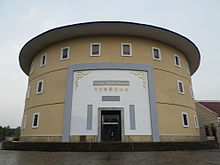
Migration of Hakka people to Indonesia happened in several waves. The first wave landed in Riau Islands such as in Bangka Island and Belitung as tin miners in the 18th century. The second group of colonies were established along the Kapuas River in Borneo in the 19th century, predecessor to early Singapore residents. In the early 20th century, new arrivals joined their compatriots as traders, merchants and labourers in major cities such as Jakarta, Surabaya, Bandung, Medan, etc.

Some research shows that the establishment of the Silk Road created commercial trade for the Hakka people in the south or along the way, and created conditions for overseas migration. The book "An Overview of Hakka Migration History: Where are you from?" published by My China Roots & CBA Jamaica mentions that the Hakka people traded with the caravans and stayed overseas to facilitate business, and added descendants Immigrants, Indonesia, Calcutta, Toronto, and Jamaica all still retain a long history of Hakka culture and organization. [57]

In Indonesia, Malaysia and Singapore, Hakka people are sometimes known as Khek, from the Hokkien pronunciation kheh. However, the use of the word 'Khek' is limited mainly to areas where the local Chinese population is mainly of Hokkien origin. In places where other Chinese subgroups predominate, the term 'Hakka' is still the more commonly used.

Bangka (in Indonesia)

Hakka also live in Indonesia's largest tin producer islands of Bangka Belitung Islands province. They are the second majority ethnic group after Malays. The Hakka population in the province is also the second largest in Indonesia after West Kalimantan's and one of the highest percentages of Chinese living in Indonesia.

The first group of Hakka in Bangka and Belitung reached the islands in the 18th century from Guangdong. Many of them worked as tin mining labourers. Since then, they have remained on the island along with the native Malay. Their situation was much different from those of Chinese and native populations of other regions, where legal cultural conflicts were prevalent since the 1960s until 1999, by which Indonesian Chinese had finally regained their cultural freedoms. Here they lived together peacefully and still practiced their customs and cultural festivals, while in other regions they were strictly banned by government legislation prior to 1999.[58] Hakka on the island of Bangka spoke Hopo dialect mixed with Malay, especially in younger generations. Hakka spoken in Belinyu area in Bangka is considered to be standard.

West Kalimantan (in Indonesia)
Hakka people in Pontianak live alongside Teochew speaking Chinese. While the Teochews are dominant in the centre of Pontianak, the Hakka are more dominant in small towns along the Kapuas River in the regencies of Sanggau, Sekadau and Sintang. Their Hakka dialect is originally Hopo which influenced by Teochew dialect and also has vocabulary from the local Malay and Dayak tribes. The Hakka were instrumental in the Lanfang Republic.

The Hakka in this region are descendants of gold prospectors who migrated from China in the late 19th century.

The Hakka in Singkawang and the surrounding regencies of Sambas, Bengkayang, Ketapang and Landak speak a different standard of Hakka dialect to the Hakkas along the Kapuas River. Originally West Borneo has diverse Hakka origin but during the 19th century, a large people came from Jiexi so more Hakkas in the region speak Hopo mixed with Wuhua and Huilai accents that eventually formed the dialect of Singkawang Hakka.[59]

Jakarta (in Indonesia)
Hakka people in Jakarta mainly have roots from Meizhou, who came in the 19th century. Secondary migration of the Hakkas from other provinces like Bangka Belitung Islands and West Borneo came later.

East Timor

There was already a relatively large and vibrant Hakka community in East Timor before the 1975 Indonesian invasion. According to an estimate by the local Chinese Timorese association, the Hakka population of Portuguese Timor in 1975 was estimated to be around 25,000 (including a small minority of other Chinese ethnicities from Macau, which like East Timor was a Portuguese colony). According to a book source, an estimated 700 Hakka were killed within the first week of invasion in Dili alone. No clear numbers had been recorded since many Hakka had already escaped to neighbouring Australia. The recent re-establishment of Hakka associations in the country registered approximately 2,400 Hakka remaining, organised into some 400 families, including part-Timorese ones.

The Timorese Hakka diaspora can currently be found in Darwin, Brisbane, Sydney and Melbourne in Australia; in Portugal; in Macau; and in other parts of the world in smaller numbers. They often are highly educated and many continue their education in either Taiwan or the People's Republic of China, while a majority of the younger generation prefer to study in Australia. The Australian government took some years to assess their claims to be genuine refugees and not illegal immigrants, as partially related to the political situation in East Timor at the time. As Asian countries were neither willing to accept them as residents nor grant them political asylum to the Timorese in general, they were forced to live as stateless persons for some time. Despite this condition, many Hakka had become successful, establishing restaurant chains, shops, supermarkets and import operations in Australia. Since the independence of East Timor in 2000, some Hakka families had returned and invested in businesses in the newborn nation.[citation needed]

South Asia
India
There used to be 1500 Hakkas largely at Tangra and Bombay, arriving after the great British Raj violence and chaos.

However, from the 1960s, after armed fighting broke out, there has been a steady migration to other countries, which accelerated in the succeeding decades. The majority moved to Britain and Canada, while others went to the United States, Australia, Taiwan, Austria and Sweden. The predominant dialect of Hakka in these communities is Meixian.

Hakkas are the largest Chinese community in India after Chinese Cantonese people of Indian ancestry. During the time he held office in Calcutta until the late 2000s, Yap Kon Chung, the Hakka ambassador, protected and helped the Chinese residents in India. Specifically, during the Sino-Indian war of 1962, oppression of Sino-Indian residents accused of Anti-Indian sentiment by the Indians was escalated. Yap then made appeals to Prime Minister Nehru to bridge a bond between the Indians and Chinese persons. During his office, he was also the principal at a highly regarded school as well as a political facilitator who helped many families migrate to other countries such as Britain, Canada, the United States and parts of Europe until he himself migrated to Toronto, Canada to join his family. Yap died surrounded by family on 18 April 2014, at the age of 97.[citation needed]

Africa
South Africa
Some Hakka people, notably from Taiwan[citation needed], migrated to South Africa.

Mauritius
The vast majority of Mauritian Chinese are Hakkas. Most Mauritian Hakkas who emigrated to Mauritius in the mid-1940s came from Northeastern Guangdong, especially from the Meizhou or Meixian region.

As of 2008, the total population of Sino-Mauritian, consisting of Hakka and Cantonese, is around 35,000.

Réunion
Many Chinese people in Réunion are of Hakka origin.[60] They either came to Réunion as indentured workers or as voluntary migrants.[60]

Americas
United States
Hakka from all over the world have also migrated to the USA. One group is the New England Hakka Association, which reminds its members not to forget their roots. One example is a blog by Ying Han Brach called "Searching for My Hakka Roots". Another group is the Hakka Association of New York, which aims to promote Hakka culture across the five boroughs of New York City.[61] In the mid-1970s, the Hakka Benevolent Association in San Francisco was founded by Tu Chung. The association has strong ties with the San Francisco community and offers scholarships to their young members. There are significant Hakka American communities in San Francisco, San Jose, Seattle and Los Angeles.

There are around 20,000 Taiwanese Hakkas in the United States.[citation needed]

Canada
There are several Hakka communities across Canada. One group that embraces on Hakka culture in this diverse country is the Hakka Heritage Alliance. Also see Jamaica.

Jamaica
Most Chinese Jamaicans are Hakka; they have a long history in Jamaica. Between 1854 and 1884, nearly 5,000 Hakkas arrived in Jamaica in three major voyages. The Hakkas seized the opportunity to venture into a new land, embracing the local language, customs and culture. During the 1960s and 1970s, substantial migration of Jamaican Hakkas to the US and Canada have occurred.[62] The Hakkas in Jamaica came mainly from Dongguan, Huiyang and Bao'an counties of Guangdong Province.[53]

Suriname
The Chinese in Suriname are homogeneous as a group and the great majority can trace their roots to Huidong'an (惠东安). One famous Hakka is President Henk Chin A Sen.[53]

Guyana
Chinese people are a small minority at Guyana. Guyana's most prominent Hakka Chinese is its first president, Arthur Chung.

Oceania
Australia
Hakka people first arrived in Australia in the 1880s. Hakka arrivals were halted along with other Chinese immigrants during the White Australia policy era from 1901 to 1973 and resumed thereafter. Some estimate that there are now 100,000 Hakka people in Australia.[63]

New Zealand
There are people of Hakka descent in New Zealand.[64][65]

Tahiti
Hakka people first arrived in Papara, Tahiti in 1865. [66]

Population
At a 1994 seminar of the World Hakka Association held in Meixian, statistics showed that there were 6,562,429 Hakkas living abroad.[21]

In 2000, the worldwide population of Hakka was estimated at 36,059,500 and in 2010 it was estimated at 40,745,200.[citation needed]

Another estimate is that approximately 36 million Hakka people are scattered throughout the world. More than 31 million lives in over 200 cities and counties spread throughout five provinces of China (Guangdong, Jiangxi, Guangxi, Fujian, Hunan) as well as Hong Kong.[67]

| Region | Hakka | Chinese | Total | Percentage | Majority | Source |
|---|---|---|---|---|---|---|
| 4,202,000 | 22,813,000 | 23,374,000 | 18.4% | Second largest | Hakka Affairs Council, Taiwan, 2014[68] | |
| 1,250,000 est | 6,643,000 | 7,300,000 | 18.8% | Second largest | Prof Lau Yee Cheung, Chinese University of Hong Kong, 2010 [69] | |
| 232,914 | 2,794,000 | 3,771,700 | 8.3% | Fourth largest | Singapore census, 2010[70] | |
| 1,650,000 | 6,550,000 | 30,116,000 | 25.2% | Second largest | Malaysia census, 2015[71][72] | |
| 1,502,846 | 9,392,792 | 67,091,371 | 16.0% | Second largest | The World Factbook, 2012[73] |
Hakkaology

Hakkaology (客家學) is the academic study of the Hakka people and their culture. It encompasses their origins, identity, language, traits, architecture, customs, food, literature, history, politics, economics, diaspora and genealogical records.

The study of the Hakka people first drew attention to Chinese and foreign scholars, adventurers, missionaries, travellers and authors of the Taiping Heavenly Kingdom era. Ernest John Eitel, a prominent German missionary, was one of those who took a great interest in this area.[74] Theodore Hamberg, who also wrote an early English-language account of the Taiping Rebellion, is also considered a forefather of Hakka studies in the West.[citation needed]

Many foreign scholars were full of admiration of the Hakka people. According to prominent sinologist Victor Purcell, the Hakkas "have a stubbornness of disposition that distinguishes them from their fellow Chinese".

Political and military leadership
It has been suggested that Hakkas have had a significant influence, disproportionate to their smaller total numbers, on the course of modern Chinese and overseas Chinese history, particularly as a source of revolutionary, political, military leaders, as well as presidents, prime ministers.[26]

Hakkas started and formed the backbone of the Taiping Heavenly Kingdom,[75] the largest uprising in the modern history of China. The uprising, also known as Jintian Uprising, originated at the Hakka village of Jintian in Guiping, Guangxi province. It was led by the failed Qing scholar, Hong Xiuquan, who was influenced by Protestant missionaries. Hong's charisma tapped into a consciousness of national dissent which identified with his personal interpretations of the Christian message. His following, who were initially Hakka peasants from Guangxi, grew across the southern provinces.

The Taiping army, which included women in their ranks, captured towns and cities from the defenders, the Taiping troops killed all Manchu children because the Taiping troops with fatal rocks smashed Manchu children's heads[76] Four of the six top Taiping leaders are Hakkas: Hong Xiuquan, Feng Yunshan, Yang Xiuqing and Shi Dakai. Hong Rengan, the Premier of the Kingdom, was the first person in China to advocate a federal government and reform. The kingdom lasted from 1851 to 1864.

Hakkas continued to play leading roles during the Xinhai Revolution that overthrew the Qing dynasty and the republican years of China. When Sun Yat-sen was a child, he used to listen to an old Taiping soldier telling them stories about the heroics of the Taipings.[77] This influenced Sun and he proclaimed that he shall be the second Hong Xiuquan. Sun was to become the Father of modern China and many of his contemporaries were his fellow Hakkas.[78]

Zheng Shiliang, a medical student and classmate of Sun, led the Huizhou Uprising (惠州起義) in 1900. Huizhou is an area in Guangdong province where most of the population are Hakkas. Deng Zhiyu led the Huizhou Qinühu Uprising (惠州七女湖起義) in 1907. All of the Four Martyrs of Honghuagang (紅花崗四烈士) are Hakkas – one of which was Wen Shengcai who assassinated the Manchu general, Fu Qi, in 1911.

Brothers Hsieh Yi-qiao and Hsieh Liang-mu raised the 100,000 Chinese Yuan needed for the Huanghuagang Uprising from the overseas Chinese community in Nanyang (Southeast Asia) in 1911. At least 27 of the 85 (initially 72 because only 72 bodies could be identified) martyrs of Huanghuagang are Hakkas. Yao Yuping led the Guangdong Northern Expeditionary Force (廣東北伐軍) to successive victories against the Qing Army which were vital in the successful defence of the Provisional Government in Nanjing and Puyi's early abdication.[79]

Liao Zhongkai and Deng Keng were Sun Yat-sen's main advisors on financial and military matters respectively. A big majority of the soldiers in the Guangdong Army (粵軍) were Hakkas.[80] Other Hakkas for example, Eugene Chen, was an outstanding foreign minister in the 1920s. Some of the best of Nationalist China generals: Chen Mingshu, Chen Jitang, Xue Yue, Zhang Fakui, and Luo Zhuoying amongst many others are Hakka as well.

The Hakka occupied communist Bases reached a peak of more than 30,000 square kilometres and a population that numbered more than three million, covering mostly Hakka areas of two provinces: Jiangxi and Fujian. The Hakka city of Ruijin was the capital of the republic.[81]

When it was overrun in 1934 by the Nationalist army in the Fifth of its Encirclement campaigns, the Communists began their famous Long March with 86,000 soldiers, of which more than 70% were Hakkas. The Fifth Encirclement Campaign was led by Nationalist Hakka general, Xue Yue. During the retreat, the Communists managed to strike a deal with the Hakka warlord controlling Guangdong province, Chen Jitang, to let them pass through Guangdong without a fight. When the People's Liberation Army had its rank structure from 1955 to 1964, the highest number of generals, totalling 54, came from the small Hakka county of Xingguo in Jiangxi province. The county had also previously produced 27 Nationalist generals. Xingguo county is thus known as the Generals' County.[81]

During the same period, there were 132 Hakkas out of 325 generals in Jiangxi, 63 Hakkas out of 83 generals in Fujian, and 8 Hakkas out of 12 generals in Guangdong respectively, not mentioning those from Guangxi, Sichuan and Hunan. The number could have been significantly higher if the majority of the personnel who started the Long March had not perished before reaching its destination. Only less than 7,000 of the original 86,000 personnel had survived it.[81]

Prominent Hakka communist leaders include: Marshal Zhu De, the founder of the Red Army, later known as the People's Liberation Army; Ye Ting, Commander-in-chief, New Fourth Army, one of the two main Chinese communist forces fighting the Japanese during the World War II (the other main communist force, Eighth Route Army, was commanded by Zhu De); Marshal Ye Jianying, governor of Guangdong; and Hu Yaobang, where the memorial for his funeral sparked off a pro-democracy movement which led to the Tiananmen Square protests in 1989. In Guangdong, China's most prosperous province, the "Hakka clique" (客家帮) has consistently dominated the provincial government. Guangdong's Hakka governors include Ye Jianying, Ding Sheng, Ye Xuanping and Huang Huahua.[82]

Besides playing major roles in all the three major revolutions of China, Hakkas had also been prominently involved in many of the wars against foreign intrusion of China. During the First Opium War, Lai Enjue led the Qing navy against the British at the Battle of Kowloon in 1839 and Yan Botao commanded the coastal defence at the Battle of Amoy in 1841. Feng Zicai and Liu Yongfu were instrumental in the defeat of the French at the Battle of Bang Bo which led to the French Retreat from Lạng Sơn and the conclusion of the war in 1885. When the Japanese invaded Taiwan, the Hakka militia forces led by Qiu Fengjia, were able to put up a stiff resistance to the Japanese when the Qing army could not. During the Battle of Shanghai in the Second Sino-Japanese War in 1937, the heroism of Xie Jinyuan and his troops, known as the "Eight Hundred Warriors" (八百壯士) in Chinese history, gained international attention and lifted flagging Chinese morale in their successful Defence of Sihang Warehouse against the better equipped Japanese. However, in the ensuing Battle of Nanjing, seventeen Nationalist generals were killed in action, of which six were Hakkas.

During the war against the Japanese, both the commander-in-chiefs of the two main Chinese communist forces, Eighth Route Army and New Fourth Army, are Hakkas: Zhu De and Ye Ting. On the Nationalist side, Xue Yue and Zhang Fakui were commander-in-chiefs for the 9th and 4th War Zones respectively. Called the "Patton of Asia" by the West and the "God of War" (戰神) by the Chinese, Xue was China's most outstanding general during the war, having won several major battles that killed hundreds of thousands of Japanese troops. Luo Zhuoying was the commander-in-chief for the (China's first participation of a war overseas), 1942.

During the Japanese occupation of Hong Kong from 1941 to 1945, the Dong River Column guerrilla force (東江縱隊) was a constant harassment to the Japanese troops. The force, whose members were mostly Hakkas and led by its commander Zeng Sheng, was highly successful due to its strong Hakka network. Noteworthy accomplishments of the partisan guerrilla force included the aiding of British and Commonwealth (British Raj Colonial rulers) prisoners of war to escape successfully from Japanese internment camps and the rescuing of twenty American pilots who parachuted into Hong Kong when they were shot down.[83]

Overseas Hakkas have also been prominent politicians in the countries they had migrated to, many of which are leading political figures of the countries or the Chinese communities there. Since the 20th century, there have been twenty Hakkas who had become heads of state or heads of government in different countries.

In popular culture
- The Guest People (Chinese: 客家之歌), a 1997 30-episode Singapore television drama about four young Hakka men who migrated from China to Singapore in the 1950s and were caught in the tumultuous anti-colonial period of the country's history. The Hakka-language version of the drama was broadcast in Taiwan. The drama was nominated for the Best Drama Series awards in the Asian Television Awards and the New York Television Festival, 1998.
- 1895 or Blue Brave: The Legend of Formosa 1895 (Chinese: 1895乙未), a 2008 Taiwan Hakka-language film about the Hakka militias fighting the Japanese during the Japanese invasion of Taiwan in 1895. The edited version for television won the Best Drama Series award in the Asian Television Awards, 2009.
- The Great Southern Migration (Chinese: 大南迁 or 葛藤凹), a 2012 32-episode China television drama about the Hakkas' migration to Southern China during the late Tang dynasty in the 9th century.
- Hakka Women (Chinese: 客家女人) or To Be or Not to Be (Chinese: 来生不做香港人), a 2014 25-episode Hong Kong television drama about the lives of two Hakka sisters separated when young, one in Hong Kong and the other in China.
- Gold Leaf (Chinese: 茶金), a 2021 Taiwanese period drama about the booming tea trade in Taiwan during the 1950 and a Hakka Taiwanese tea trader family owned tea exporting company.
See also
- Hakka architecture
- Hakka cuisine
- Hakka hill songs
- Hakka language
- Hakka opera
- Larut War
- Lee Youn Chin
- Punti–Hakka Clan Wars
- Tea-picking opera
Further reading
People and identity
- Char, Tin-Yuke (1969). The Hakka Chinese – Their Origin & Folk Songs. Jade Mountain Press.
- Eberhard, Wolfram (1974). Studies in Hakka Folktales. Taipei: Chinese Association for Folklore.
- Kiang, Clyde (July 1991). The Hakka Search for a Homeland. Allegheny Press. ISBN 9780910042611.
- Constable, Nicole, ed. (1996). Guest People: Hakka Identity in China and Abroad. University of Washington Press. ISBN 9780295984872.
- Leong, Sow-Theng (1997). Wright, Tim (ed.). Migration and Ethnicity in Chinese History: Hakkas, Pengmin and Their Neighbors. Stanford University Press. ISBN 9780804728577.
- Chung, Yoon-Ngan (2005). The Hakka Chinese: Their Origin, Folk Songs and Nursery Rhymes. Poseidon Books. ISBN 978-1921005503.
- Leo, Jessieca (September 2015). Global Hakka: Hakka Identity in the Remaking. BRILL. ISBN 9789004300262.
Politics
- Erbaugh, Mary S. (December 1992). "The Secret History of the Hakkas: The Chinese Revolution as a Hakka Enterprise". The China Quarterly. 132 (132): 937–968. doi:10.1017/S0305741000045495. JSTOR 654189. S2CID 154584671.
- Spence, Jonathan D. (December 1996). God's Chinese Son: The Taiping Heavenly Kingdom of Hong Xiuquan. W. W. Norton & Company. ISBN 9780393315561.
- Zhang, Delai (2002). The Hakkas of Sabah: A Survey of Their Impact on the Modernization of the Bornean Malaysian State. Sabah Theological Seminary. ISBN 9789834084004.
- Yong, Kee Howe (July 2013). The Hakkas of Sarawak: Sacrificial Gifts in Cold War Era Malaysia. University of Toronto Press. ISBN 9781442615465.
- Lee, Wei Ling (January 2015). Yap, Koon Hong (ed.). A Hakka Woman's Singapore Stories: My Life as a Daughter, Doctor and Diehard Singaporean. Straits Times Press. ISBN 9789814642477.
- Liu, L. Larry (January 2015). Hakkas in Power: A Study of Chinese Political Leadership in East and Southeast Asia, and South America. Create Space Independent Publishing Platform. ISBN 9781505429435.
Language
- Lee, T.H. (1955). Hakka Lessons for Malayan Students. Government Federation of Malaya.
- Tsang, Joseph Mang Kin (January 2003). The Hakka Epic. President's Fund for Creative Writing in English. ISBN 9789990397406.
- Chen, Matthew Y.; Lian, Hee Wee; Yan, Xiuhong (2004). The Paradox of Hakka Tone Sandhi. Dept of Chinese Studies, National University of Singapore. ISBN 9789810519438.
- Hashimoto, Mantaro J. (June 2010). The Hakka Dialect: A Linguistic Study of its Phonology, Syntax and Lexicon. Cambridge University Press. ISBN 9780521133678.
Religion
- Constable, Nicole (August 1994). Christian Souls and Chinese Spirits: A Hakka Community in Hong Kong. University of California Press. ISBN 9780520083844.
- Lutz, Jessie G.; Lutz, Rolland Ray (January 1998). Hakka Chinese Confront Protestant Christianity, 1850-1900: With the Autobiographies of Eight Hakka Christians, and Commentary. Routledge. ISBN 9780765600387.
- Christofferson, Ethan (September 2012). Negotiating Identity: Exploring Tensions between Being Hakka and Being Christian in Northwestern Taiwan. Wipf & Stock Publishers. ISBN 9781610975032.
Food
- Anusasananan, Linda Lau (October 2012). The Hakka Cookbook: Chinese Soul Food from around the World. University of California Press. ISBN 9780520273283.
Family stories
- Tan, Amy (October 1995). The Hundred Secret Senses. Penguin Books. ISBN 9780399141157. The book was shortlisted for the 1996 Orange Prize for Fiction.[84]
- Lee, J.P. (January 2004). Breaking the Curse of the Green Dragon (A Hakka Story). Instrument of Truth. ISBN 9789810480424.
- Chin, Woon Ping (June 2008). Hakka Soul: Memories, Migrations and Meals. University of Hawaii. ISBN 9780824832896.
- Huang, Suhua (April 2012). A Faithful Reading Partner: A Story from a Hakka Village. AuthorHouse. ISBN 9781468562675.
- Lampotang, Peggy (January 2014). The Coral Heart: A Shopkeeper's Journey. Atelier d'ecriture. ISBN 9789990336924.
- Sze, Elsie (February 2014). Ghost Cave: A Novel of Sarawak. Hong Kong Women in Publishing Society. ISBN 978-1496073945.
- Hsiung, C. Fong (September 2014). Picture Bride. Mawenzi House/TSAR Publishers. ISBN 9781927494394.
- Lin Ung, Charlene (March 2015). Nam Moi: A Young Girl's Story of Her Family's Escape from Vietnam. Createspace Independent Publishing Platform. ISBN 9781508700791.
- Madison, Paula Williams (April 2015). Finding Samuel Lowe: China, Jamaica, Harlem. Amistad. ISBN 9780062331632.
References
- ^ a b Rubinstein, Murray A. (2004), "Rethinking Taiwanese and Chinese Identity: Melissa J. Brown's Is Taiwan Chinese?" (PDF), iir.nccu.edu.tw, vol. 40, Institute of International Relations, pp. 454–458, ISSN 1013-2511, OCLC 206031459, archived from the original (PDF) on 27 July 2011
- ^ a b "客家文化探密:怀念先人 感念生活 客家人闹元宵". news.sina.com.cn.
- ^ "Hakka culture GuangdongCulture". Newsgd.com. Retrieved 15 January 2015.
- ^ Yen, Ching-hwang (21 July 2008). The Chinese In Southeast Asia and Beyond: Socioeconomic and Political Dimensions. World Scientific. p. 379. ISBN 978-981-4471-99-2.
- ^ LaCroix, Frederick E. (2009). The sky rained heroes: A journey from war to remembrance. Austin: Synergy Books. p. 56. ISBN 978-0-9821601-3-8.
- ^ Li, Hui; Pan, Wu-Yun; Wen, Bo; Yang, Ning-Ning; Jin, Jian-Zhong; Jin, Li; Lu, Da-Ru (September 2003). "Origin of Hakka and Hakkanese: a genetics analysis". Acta Genetica Sinica. 30 (9): 873–880. PMID 14577381.
- ^ a b c "The Hakka: The Jews of Asia". Edu.ocac.gov.tw. Archived from the original on 9 September 2019. Retrieved 15 January 2015.
- ^ "Welcome to Longyan Municipal People's Government, PRC". English.longyan.gov.cn. Archived from the original on 6 April 2014. Retrieved 15 January 2015.
- ^ Kuo, Huei-Ying. Networks beyond Empires: Chinese Business and Nationalism in Hong Kong ….
- ^ "The Hakka People". 全球華文網路教育中心. Archived from the original on 9 September 2019. Retrieved 25 September 2011.
- ^ a b c d e Chen, Jieming; Zheng, Houfeng; Bei, Jin-Xin; Sun, Liangdan; Jia, Wei-hua; Li, Tao; Zhang, Furen; Seielstad, Mark; Zeng, Yi-Xin; Zhang, Xuejun; Liu, Jianjun (1 December 2009). "Genetic Structure of the Han Chinese Population Revealed by Genome-wide SNP Variation". The American Journal of Human Genetics. 85 (6): 775–785. doi:10.1016/j.ajhg.2009.10.016. PMC 2790583. PMID 19944401.
- ^ a b c Luo, Chunfang; Duan, Lizhong; Li, Yanning; Xie, Qiqian; Wang, Lingxiang; Ru, Kai; Nazir, Shahid; Jawad, Muhammad; Zhao, Yifeng; Wang, Fenfen; Du, Zhengming; Peng, Dehua; Wen, Shao-Qing; Qiu, Pingming; Fan, Haoliang (24 May 2021). "Insights From Y-STRs: Forensic Characteristics, Genetic Affinities, and Linguistic Classifications of Guangdong Hakka and She Groups". Frontiers in Genetics. 12. doi:10.3389/fgene.2021.676917. ISSN 1664-8021. PMC 8181459. PMID 34108995.
- ^ a b c Feng, Yuhang; Zhao, Yutao; Lu, Xiaoyu; Li, Haiyan; Zhao, Kai; Shi, Meisen; Wen, Shaoqing (22 January 2024). "Forensic analysis and sequence variation of 133 STRs in the Hakka population". Frontiers in Genetics. 15: 1347868. doi:10.3389/fgene.2024.1347868. ISSN 1664-8021. PMC 10839782. PMID 38317659.
- ^ Herold Jacob Wiens (1954). "Chapter VIII: Ethnic Distribution". China's march toward the tropics: a discussion of the southward penetration of China's culture, peoples, and political control in relation to the non-Han-Chinese peoples of south China and in the perspective of historical and cultural geography. Shoe String Press. p. 270. LCCN 54013401. OCLC 576470153.
taste which alone are sufficient to demonstrate that the ancestors of the Hakka had long been in the ranks of the Han-Chinese civilization. In the Hakka region, more than elsewhere in Ling-nan, are such excellent old names as Fu-yung-chang (Hibiscus Range), Chin-p'ing Shan (Brocade-screen Mountains), Sung-yuan-ch'i (Pine-springs)
- ^ Constable, Nicole (2005). Guest People: Hakka Identity in China and Abroad. Seattle: Univ. of Washington Press. p. 9. ISBN 9780295984872.
- ^ a b Hu, SP; Luan, JA; Li, B; Chen, JX; Cai, KL; Huang, LQ; Xu, XY (January 2007). "Genetic link between Chaoshan and other Chinese Han populations: Evidence from HLA-A and HLA-B allele frequency distribution". American Journal of Physical Anthropology. 132 (1): 140–50. doi:10.1002/ajpa.20460. PMID 16883565.
- ^ a b c d e f Wang, WZ; Wang, CY; Cheng, YT; Xu, AL; Zhu, CL; Wu, SF; Kong, QP; Zhang, YP (January 2010). "Tracing the origins of Hakka and Chaoshanese by mitochondrial DNA analysis". American Journal of Physical Anthropology. 141 (1): 124–30. doi:10.1002/ajpa.21124. PMID 19591216.
- ^ "Related Topics: Non-legal Considerations: Language". Taiwandocuments.org. Retrieved 15 January 2015.
- ^ Cheung, Sidney C.H. (1998). On the south China track: Perspectives on anthropological research and teaching. Hong Kong: Hong Kong Institute of Asia-Pacific Studies, Chinese University of Hong Kong. p. 160. ISBN 978-962-441-540-7.
- ^ Choon, Yoon Ngan (2005). The Hakka Chinese: Their Origin, Folk Songs And Nursery Rhymes. BURLEIGH MDC QLD. 4220, AUSTRALIA: Poseidon Books. ISBN 978-1-921005-50-3.
{{cite book}}: CS1 maint: location (link) - ^ a b Lee, Khoon Choy (2006). Pioneers of modern China : understanding the inscrutable Chinese. River Edge, New Jersey: World Scientific Publishing. p. 62. ISBN 9789812566188.
- ^ Lu Guoyao (魯國堯), On Gan-Hakka and the Tongtai dialect derived from lingua franca of Southern Dynasties (客、贛、通泰方言源於南朝通語說), 2003, ISBN 7-5343-5499-4, pages 123–135
- ^ Thurgood, Graham; LaPolla, Randy J., eds. (2003). The Sino-Tibetan Languages. Routledge. ISBN 0-7007-1129-5.
- ^ 黃玉振 (25 May 2011). "不僅只有台灣閩南語,台灣客家語也是「台語」!". 行政院客家委員會. Archived from the original on 28 September 2013. Retrieved 17 April 2012.
只要是共同生長於台灣這塊土地上的所有族群的成員,他們不僅都是台灣人,而且他們所操持的族群語言也都是「台灣話」(或「台語」)!
- ^ UNESCO World Heritage Centre. "Fujian Tulou". Whc.unesco.org. Retrieved 15 January 2015.
- ^ a b Davis, Edward L. (2005). Encyclopedia of Contemporary Chinese Culture. London: Routledge. p. 333. ISBN 9780415241298.
- ^ Lozada, Eriberto (2005). Ember, Carol R.; Ember, Melvin; Skoggard, Ian (eds.). Encyclopedia of Diasporas: Immigrant and Refugee Cultures Around the World. Vol. 2. Dordrecht, Netherlands: Springer Science & Business Media. pp. 92–103. ISBN 9780306483219.
- ^ "客家夥房的土地龍神". Archived from the original on 19 April 2012. Retrieved 10 August 2017.
- ^ Zhang, Wei-Bin (December 2007). "New China's Long March from Servility to Freedom". Nova Science Publication.
- ^ The Hakka Odyssey & their Taiwan homeland. p. 120, Clyde Kiang. 1992
- ^ Goodman, Bryna (20 October 1995). Native Place, City, and Nation: Regional Networks and Identities in Shanghai, 1853–1937. University of California Press. p. 80. ISBN 9780520915459.
- ^ The Broken Wave: The Chinese Communist Peasant Movement, 1922–1928, Volume 90 By Roy Hofheinz [1]
- ^ Bianco, Lucien (4 March 2015). Peasants without the Party: Grassroots Movements in Twentieth-Century China: Grassroots Movements in Twentieth-Century China. Routledge. ISBN 9781317463108 – via Google Books.
- ^ "Townsmen Sentiment Always Serves as a Link". en.people.cn.
- ^ "Ganzhou.China". Gndaily.com. Archived from the original on 4 March 2016. Retrieved 15 January 2015.
- ^ Yingcong Dai (2009). The Sichuan Frontier and Tibet: Imperial Strategy in the Early Qing. University of Washington Press. pp. 25–. ISBN 978-0-295-98952-5.
- ^ New Peace County, A Chinese Gazetteer of the Hong Kong Region Peter Y.L. Ng, Hong Kong University Press, 1983. ISBN 962-209-043-5.
- ^ Ng (1983), p. 84.
- ^ See p.12, 圖片 香港今昔 by 高添強 (Gao TianQiang), 三聯書店. (1997 2nd Ed.) ISBN 962-04-1180-3
- ^ Gao 1997, p.16.
- ^ a b Hase, Patrick (1995). "Alliance of Ten". In Faure, David; Siu, Helen (eds.). Down to Earth : The Territorial Bond in South China. Stanford University Press. pp. 123–160. ISBN 978-0-8047-2434-0. OCLC 31815055.
- ^ Gao, (1997)
- ^ "About the Hakka people in Taiwan". HakkaTV. Public Television Service. 5 October 2012. Retrieved 4 February 2015.
- ^ Davidson, James W. (1903). The Island of Formosa, Past and Present : history, people, resources, and commercial prospects : tea, camphor, sugar, gold, coal, sulphur, economical plants, and other productions. London and New York: Macmillan. p. 561. OCLC 1887893. OL 6931635M.
- ^ Davidson (1903), p. 590.
- ^ Davidson (1903), p. 591.
- ^ Tsai, Shih-shan Henry (19 August 2009). Maritime Taiwan: Historical Encounters with the East and the West. M.E. Sharpe. ISBN 9780765623287 – via Google Books.
- ^ Rouil, 60–61
- ^ "Reviving the Hakka Way of Life". April 2013.
- ^ Willmott (1967), p. 23-4
- ^ [2] Archived 2 February 2011 at the Wayback Machine
- ^ Joshua Project. "People Groups". joshuaproject.net.
- ^ a b c Jessieca Leo (3 September 2015). Global Hakka: Hakka Identity in the Remaking. Brill. p. 87. ISBN 9789004300279.
- ^ Chong, Tet Loi (2002). The Hakkas of Sabah : a survey of their impact on the modernization of the Bornean Malaysian State. Sabah Theological Seminary. pp. 32–33.
- ^ Jessieca Leo (3 September 2015). Global Hakka: Hakka Identity in the Remaking. Brill. pp. 75–76. ISBN 9789004300279.
- ^ Chong, Tet Loi (2002). The Hakkas of Sabah: A Survey on Their Impact on the Modernization of the Bornean Malaysian State. Kota Kinabalu: Sabah Theological Seminary. p. 28. ISBN 978-983-40840-0-4. OCLC 51876445.
- ^ “An overview of Hakka migration history: where are you from?”. My China Roots & CBA Jamaica. July, 2016. https://cbajamaica.com/assets/docs/HANDOUT_Hakka_Migration_History.182201835.pdf
- ^ "Kebersamaan Tanpa Prasangka". KOMPAS. 23 August 2006. Retrieved 10 September 2007.
- ^ "United Singkawang – Bahasa Hakka di Singkawang". Singkawang.us. Archived from the original on 8 May 2015. Retrieved 15 January 2015.
- ^ a b Thunø, Mette (2007). Beyond Chinatown: new Chinese migration and the global expansion of China. NIAS Press. p. 234. ISBN 978-87-7694-000-3. OL 13426825M. Retrieved 24 November 2009.
- ^ "Home". Hakka Association of NY. Archived from the original on 1 August 2015.
- ^ "We are Chinese Jamaicans Worldwide". We are Chinese Jamaicans Worldwide. Archived from the original on 12 May 2013.
- ^ "Galvanising the collective intelligence of the Hakka Diaspora in Western Australia". 3 July 2018.
- ^ "Living in NZ: A Chinese Descent Indian shares her unique cultural experience".
- ^ McIntyre, Nancy (2008). "Ethnic Minority migrant Chinese in New Zealand" (PDF).
- ^ "The Chinese Community in Tahiti: 150 years of history". 3 March 2015.
- ^ Hattaway, Paul (2004). Peoples of the Buddhist World: A Christian Prayer Diary. Carlisle: Piquant. ISBN 9780878083619.
- ^ "客委會人口調查 全台約18%是客家人". tw.news.yahoo.com. 12 September 2014.
- ^ "香港客家人". bj.crntt.com.
- ^ "Census of Population 2010" (PDF). Archived from the original (PDF) on 5 October 2016. Retrieved 21 May 2016.
- ^ Yeen, Oh Ing (16 June 2015). "Home for Hakka group opens". The Star Online.
- ^ "The Malaysian Chinese population is decreasing".
- ^ "The World Factbook". Retrieved 18 March 2015.
- ^ Lee, Pui-tak (1 September 2005). Colonial Hong Kong and Modern China: Interaction and Reintegration. Hong Kong University Press. ISBN 9789622097209.
- ^ Spence, Jonathan D. (1997). God's Chinese son : the Taiping Heavenly Kingdom of Hong Xiuquan. New York: W.W. Norton. ISBN 9780393315561.
- ^ The Hakka Odyssey & their Taiwan homeland. p. 157, Clyde Kiang. 1992
- ^ "Dr. Sun Yat-sen – Chinese Cultural Plaza – Honolulu, HI – Statues of Historic Figures on Waymarking.com". Waymarking.com. Retrieved 15 January 2015.
- ^ 门杰丹 (4 December 2003). 浓浓乡情系中原 – 访孙中山先生孙女孙穗芳博士 [Interview with Dr. Sun Yat-granddaughter of Dr. Sun Suifang]. chinanews.com (in Chinese). Retrieved 30 July 2012.Translate this Chinese article to English
- ^ "Yao Yuping and the Xinhai Revolution" (in Chinese). Homemy.jumzsf.come. 8 April 2013. Archived from the original on 8 November 2014. Retrieved 28 December 2014.
- ^ "5". Renwuzhuanjiwang.com. Archived from the original on 12 November 2014. Retrieved 15 January 2015.
- ^ a b c "The Secret History of the Hakkas: The Chinese Revolution as a Hakka Enterprise" (PDF). Archived from the original (PDF) on 18 June 2015. Retrieved 8 March 2015.
- ^ Discuz! Team and Comsenz UI Team. "֮_̳__˵". Suizhou.org. Archived from the original on 9 March 2012. Retrieved 15 January 2015.
- ^ Sui-Jeung, Chan (2009). East River Column. Hong Kong University Press. ISBN 9789622098503. JSTOR j.ctt1xwfs6.
- ^ "Orange past winners". Retrieved 11 May 2008.
External links
![]() Media related to Hakka people at Wikimedia Commons
Media related to Hakka people at Wikimedia Commons

See what we do next...
OR
By submitting your email or phone number, you're giving mschf permission to send you email and/or recurring marketing texts. Data rates may apply. Text stop to cancel, help for help.
Success: You're subscribed now !
